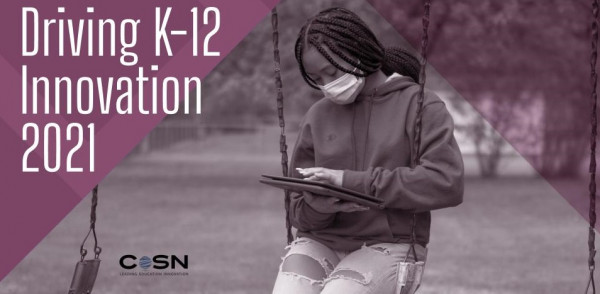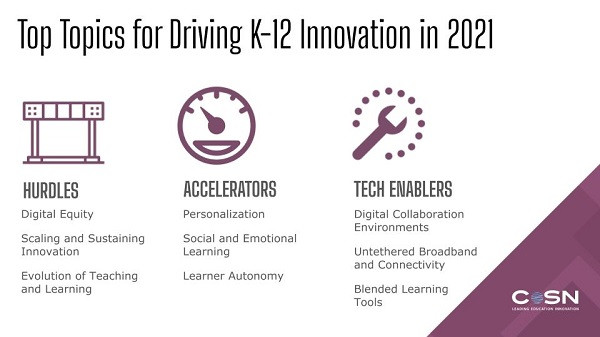Post pandemic, what are the main hurdles facing tech innovation in schools? What constraints can be expected to slow down your best-made sales plans for reaching the K-12 market? What are some of the megatrends that will affect your sales in the education market this year? And what tools will enable ed-tech adoption to grow deeper roots in our post-Rona environment? These are some of the questions answered in the COSN 2021 edition of the K-12 Driving Innovation annual report.

Although the Driving Innovation 2021 report largely speaks for itself, in this piece I will offer a bit of translation and connection. With full disclosure, I must mention that I served as one of the 111 world-wide panelists who developed this report over many months. Serving as a panelist for the report for the last eight years, I can add beneficial nuance to the findings, from an inside perspective. The full report can be accessed here.
 For now, let’s take a quick look at the hurdles, accelerators, and tech enablers that will certainly color the landscape facing ed-tech decision makers and the companies trying to sell into this market.
For now, let’s take a quick look at the hurdles, accelerators, and tech enablers that will certainly color the landscape facing ed-tech decision makers and the companies trying to sell into this market.
2021-2 Hurdles
What is a hurdle? Hurdles are “obstacles that make [schools] slow down, evaluate, practice, and then make the leap to better support teaching and learning”. Hurdles can get in the way of your best marketing plans.
What are the findings? Based on expert panel voting, the three concerns that will slow down your sales as schools figure out how to grapple with these challenges include:
- Digital Equity. The limits of equipment access, and know-how in using technology, will continue to stymie school plans/growth/purchasing over the next year.
- Scaling and Sustaining Innovation. Schools continue to struggle with taking technology to scale. They know how to make it happen in a single classroom with a motivated teacher, but generally struggle to expand beyond that.
- The Evolution of Teaching and Learning. Teaching practices and learning theories are constantly changing, forcing educators to constantly rethink what technologies make sense and how to use them. These changes have the effect of slowing tech adoption down.
2021-22 Tech Enablers
What is a tech enabler? Tech Enablers are “tools that support smoother leaps over the hurdles”.
What are the findings? There are three tech enablers that, if you hitch your messaging wagon onto their stars, they will likely speed you past some of the above-mentioned hurdles. These include:
- Digital Collaboration Environments. The newest iteration of “collaborative learning”. Do your products enable this?
- Untethered Broadband and Connectivity. Can your products advantage themselves in this regard, or are you hog-tied too closely to wired environments with heavy bandwidth requirements?
- Blended Learning Tools. Can your products enable learning experiences through “a mix of face-to-face and online interactions”, or does bandwidth bloat leave you tied only to in-class instruction?
2021-22 Accelerators
What is an accelerator? Accelerators are “megatrends that drive change” – sometimes suddenly and sometimes gradually or unnoticeably. These are developments which help speed up the rate of technology innovation in the education sector and can potentially spur adoption of your products to higher levels in schools.
What are the findings? According to the expert panel balloting, there are three accelerators that, if you again hitch your messaging wagon onto their stars, they will likely speed you towards greater market penetration. These ‘accelerators’ are growingly popular to educators, and include:
- Personalization. Customizing learning. Recognizing the variability found in classrooms. Making the dream of personalized learning more efficient, more doable. Can your product help?
- Social / Emotional Learning. Also known as SEL in education circles, this arena involves fostering mental, social, and emotional wellbeing, and includes the teaching of empathy, grit, persistence, resilience, flexibility, and adaptability. Do your products have some unique strengths in this regard?
- Learner Autonomy. Also known as student agency, will your technology permit creative and self-directed exploration and use by students, or are your products only tools in the hands of direct instruction (teacher-driven use, if you will)?
It’s perplexing, but the leadership guiding the overall report’s direction did not perceive the pandemic as slowing down tech innovation in schools, nor speeding things up. Rather, they viewed the Rona as an underlying condition. But behind the scenes many panelists disagreed, however, feeling that the pandemic has slowed down school tech buying in many categories, while ratcheting it up in others. – Len Scrogan


